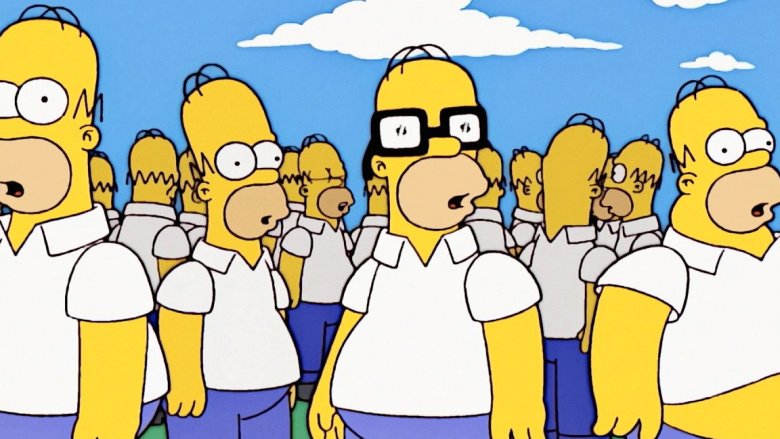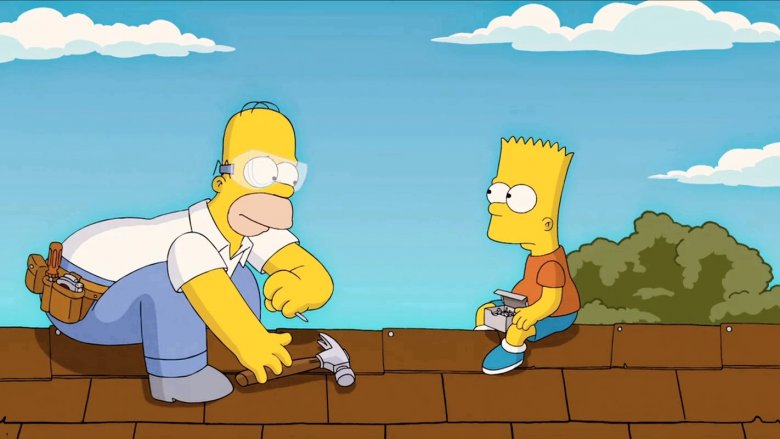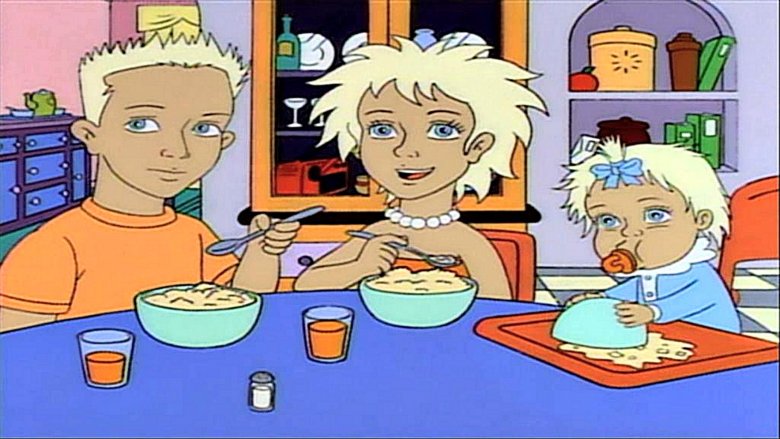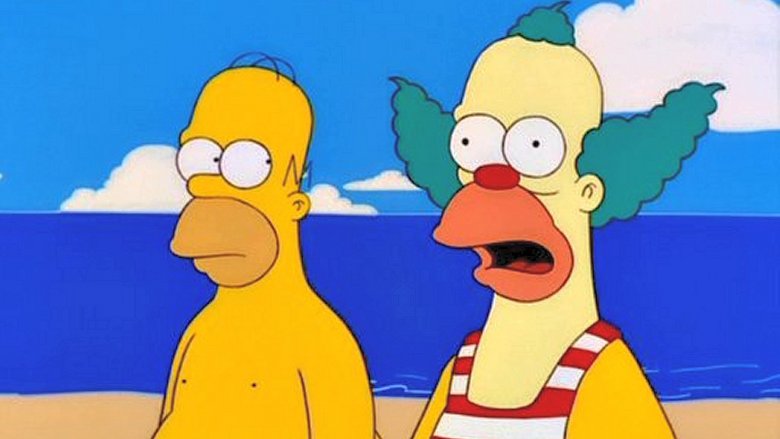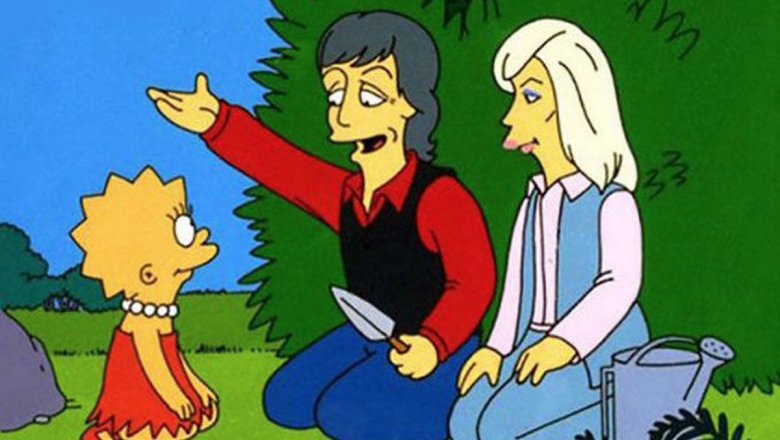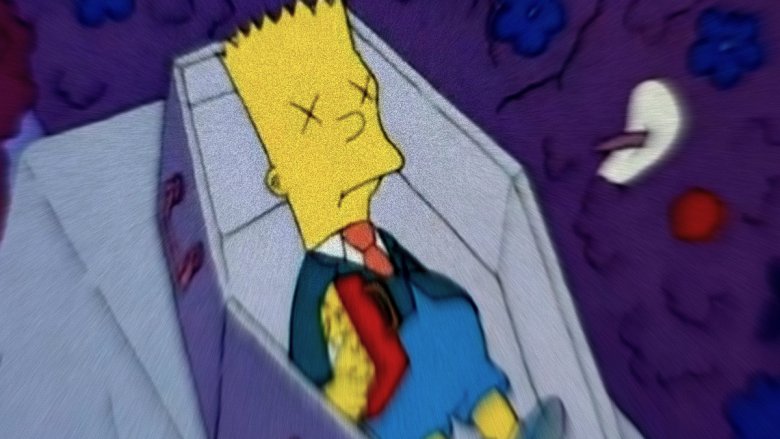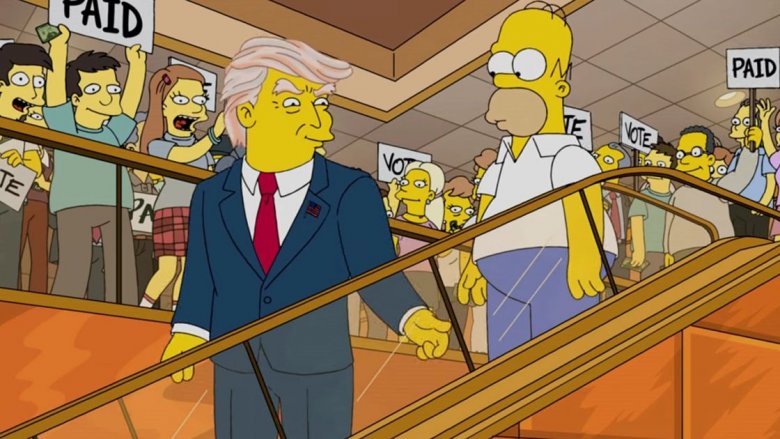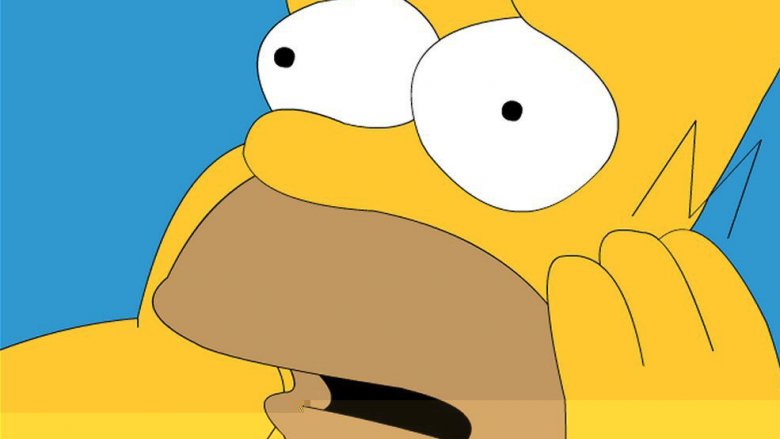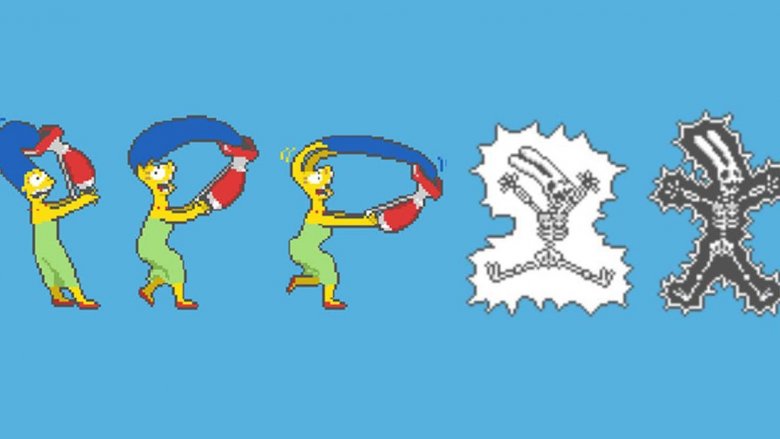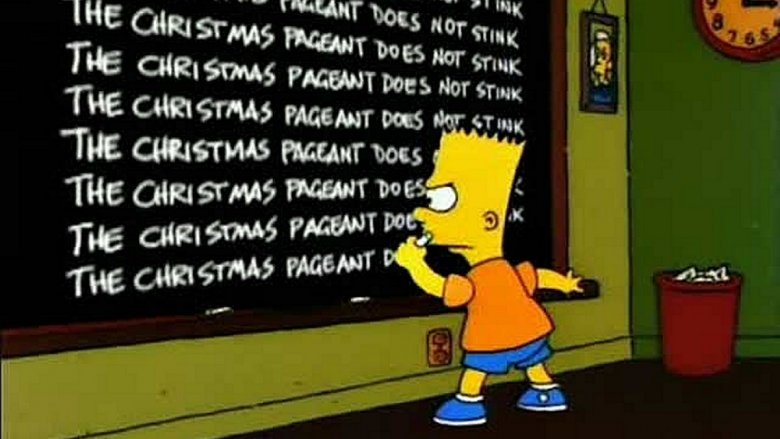Weird Things You Never Knew About The Simpsons
The Simpsons is far more than a mere television show: It's a cultural institution. The series has been around for three decades, which probably explains why the four-fingered, buggy eyed, yellow-skinned denizens of Springfield have become just as recognizable as Mickey Mouse and the McDonald's logo. These days, it's easy to forget that The Simpsons didn't pop into existence fully formed. Along the way, there were a number of bizarre developments and changes in direction.
Bart was supposed to be the main character
Homer Simpson is one of the most iconic characters in television history. His perpetually unshaven mug is stretched out onto rubber Halloween masks across the world, his catchphrase is uttered by billions, and most of the show's storylines revolve around the consequences of his stupid decisions. We've gotten so used to Homer being the face of The Simpsons that it's easy to forget that in the old days, people weren't saying "D'oh!" — they were saying "Eat my shorts."
Back then, Bart was the star attraction, according to SplitSider, and the Simpsons merchandise machine plastered Bart's spiky hair onto every lunchbox, T-shirt, and coffee mug it could find. After all, a spunky, rebellious kid with a surprisingly big heart seems like a far more natural media icon than his cranky, pot-bellied, balding father. Surprisingly enough, the show deviated from this track to instead focus on Homer, a decision often credited to writer Conan O'Brien. According to an interview with Simpsons creator Matt Groening by the Smithsonian, the idea of changing the show's focus from rebellious son to dim-witted father was for dramatic reasons because "there are more consequences to him being an idiot."
The Simpsons are yellow for a really simple reason
In real life, yellow skin is no laughing matter. Jaundice can be a sign of scary ailments, and considering both the widespread pollution in Springfield Lake and the town's close proximity to a corrupt nuclear power plant, it's hard not to get concerned about whatever bizarre medical ailment might be slowly killing the population, in addition to leaving them all with mutated appearances.
While we might never know if the Simpsons suffer from a strange disease, the real-life reason Matt Groening decided to paint his characters yellow is far more benign. In an interview with the BBC, Groening credited the yellow coloration to a sample that one of the animators showed him, and claims he decided to stick with the color simply because it would make the show stand out when viewers were flipping through the channels. As Mental Floss points out, yellow is a color that "pops" against blue backgrounds like the sky. (Spongebob Squarepants pops against the blue ocean much the same way.)
The Springfield family's bizarre features led to one particularly surreal scene, seen above, where Homer is horrified by a vision of his kids as "horrible freaks with pink skin, no overbites, and five fingers on each hand."
Krusty the Clown was supposed to be Homer's secret identity
Okay, now here's the part where things get super weird. Have you ever noticed that Krusty the Clown looks exactly like Homer, but in clown makeup and a wig? It's not a coincidence. According to Entertainment Weekly, the popular TV clown was originally created to be Homer's secret identity.
See, the plot twist was going to be that while Bart thought so little of his blue collar father, he was obsessed with the silly Krusty character he watched on TV, much to Homer's chagrin. Basically, the Superman/Clark Kent/Lois Lane dynamic, but with a kid instead of a love interest. This secret identity storyline was intended to add a tragic undercurrent to Homer's character, as he desperately sought to obtain the love and affection his son had for his masked counterpart. It was swiftly decided that this plot would be too complicated, and Krusty was repositioned as his own character. Still, looking back on it now, it's intriguing to wonder if ol' Homer might've been hiding a few other secrets up his sleeve.
Lisa is a vegetarian because of Paul McCartney
Centuries from now, The Simpsons might be best remembered as a "Who's Who" of contemporary celebrities, with countless movie stars, musicians, writers, and athletes playing animated versions of themselves. However, when legendary Beatles veteran Sir Paul McCartney was approached to appear on the show, he and his wife Linda required that the writers make one solemn vow: The character of Lisa Simpson had to adopt a vegetarian diet, and she had to stay true to it.
According to the Huffington Post, this unique request was because the McCartneys were vegetarians themselves. It's hard to say no to a former Beatle, so the writers went along, and in the episode "Lisa the Vegetarian," the most socially conscious Simpson was converted by an animated version of the McCartney couple. Voice actor Hank Azaria claims that the writers have sometimes considered having Lisa cheat on her diet, but so far, they've stayed true to their promise and arguably helped bring vegetarianism to the mainstream. Clever, Paul. Clever.
It's worth noting that despite the flak Lisa sometimes receives, she's actually Matt Groening's favorite character. In an interview with The Hollywood Reporter, Groening explains, "I always carry in my heart that she is going to grow up and escape Springfield for a better life."
The Simpsons were a sketch before they were a full series
It sometimes seems like animated TV sitcoms didn't even exist before The Simpsons, but back in the beginning, no one could have ever foreseen that a yellow family with such subversive messaging would turn out to be such a blockbuster success. In an interview with The Hollwood Reporter, Matt Groening explained that the series arose from the popularity of this rabbit-centered comic strip, Life in Hell. When Groening was approached by producers of The Tracey Ullman Show to create a short recurring cartoon sketch for the series, he was scared of using the weird bunny antiheroes of his Life in Hell strips, fearing that he might lose the rights. So instead, he came up with the Simpsons, never expecting that his new creation would go on to become his life's work.
The Simpson family shorts, which combined crude animation with biting satire, were such a huge hit on Tracey Ullman that they were then played before movies. Audience response was so fantastic that the skits were picked up for a full primetime animated series aimed at adults.
However, not everyone was happy about the show's success. According to Variety, Tracey Ullman sued 20th Century Fox over the whole shebang in 1992, claiming that she wasn't getting fair royalties. (She lost.)
There's no 'Dead Bart' episode
For years, a creepy urban legend has floated around the internet relating to the supposedly "lost" episode of The Simpsons. According to Comic Book Resources, the story goes that the production team went to great lengths to hide the existence of this episode, due to the fact that it depicts Bart Simpson gorily dying in a plane accident. This tragedy rips apart the Simpsons family, leading to extended crying sequences, as well as frequent depictions of Bart's rotting corpse, which apparently becomes more realistically drawn the longer he's dead. Since these rumors first surfaced, there have been occasional scraps of video and images which claim to be taken from the last episode.
If you think this sounds too weird to be true, you're right. The infamous "Dead Bart" episode is nothing but an internet legend created by the Creepy Pasta wiki just to rake in those sweet, sweet clicks. So yeah, it's basically like the spooky campfire stories you told as a kid, but with a digital twist where someone else makes money. That's fine, though: "Dead Bart" doesn't sound like the most enjoyable half-hour of television.
The Simpsons are named after Matt Groening's family
For anyone who might believe that the Simpson family patriarch's name is a reference to the legendary author of The Iliad, the answer is a lot more straightforward. As Groening told The Hollywood Reporter, all the Simpsons are named after his own family. Groening's late father was named Homer, his mother was Margaret, and his sisters are Lisa and Maggie. Groening has also made it clear that the characters themselves are not based on the real people, other than their names.
But what about Bart? According to the Smithsonian, the Simpson boy's original name was going to be Matt, but he changed it before pitching the project to the network. Groening says he liked the idea of an angry father yelling the name "Bart," imagining that it would sound reminiscent of a barking dog. Groening also stipulates that that the only similarity between the Simpsons father and his own is their shared love of ice cream, though the real Homer didn't care much for doughnuts.
The Simpsons 'predicted' President Trump ... sort of
In the midst of the long run-up to the 2016 U.S. presidential election, an internet meme emerged claiming that back in 2000, The Simpsons had accurately predicted billionaire Donald Trump's unexpected rise to presidential candidate, including such eerie details as Trump's ride on his escalator and even the style of his campaign logo. According to Snopes, the images in this meme actually originate from a 2015 clip, which simply adapted events (like the escalator ride) that had already occurred in real life. So yeah, not so prescient.
The one grain of truth in this whole thing is that The Simpsons did predict the rise (and controversy) of President Trump, albeit in far less detail. In the 2000 episode "Bart to the Future," Bart has a vision of a future where Lisa Simpson becomes president of the United States and casually mentions having inherited a huge budget crisis from "President Trump."(In real life, Trump had been talking about running for president for at least a year, at that point.) When Trump went on to win the 2016 election, the famous opening credits of The Simpsons reflected this by having Bart write "being right sucks" on the blackboard, according to the Washington Post.
The word 'D'oh!' wasn't in the script
When you stub your toe or hit your finger with a hammer, you might say "Oops!" or "Ow!" or you might shout something a lot more profane. But before The Simpsons, you probably didn't say "D'oh!" because no one really did.
Now, "D'oh!" has become such a well-known phrase that in 2001, it had the honor of officially being incorporated into the Oxford English Dictionary, according to the BBC. According to the dictionary itself, the original scripts for The Simpsons didn't include the phrase, merely calling for an "annoyed grunt." It was Homer actor Dan Castellaneta who came up with the sound, basing it on the "Do-o-o-o" sound used which actor Jimmy Finlayson used in the old Laurel and Hardy movies as a euphemism for the then-forbidden word "Damn." According to Britain's The Herald, it was Groening who made the call to shorten the elongated "D'ooooh!" into the short, punchy sound that we all know and shout today.
Ned Flanders is a lot older than he looks
Ned Flanders, the neat and tidy next-door neighbor, has always been positioned as Homer Simpson's opposite number. Whereas Homer is lazy and bad-mannered with poor hygiene and somewhat flexible morals, Ned is a devoted Christian with a seemingly perfect family life, a pleasant demeanor, and a kind, cheerful attitude.
The two aren't quite equal counterparts, though. While Homer is generally presented as being in his late 30s to early 40s, Ned is secretly a lot older. In the episode "Viva Ned Flanders," the religious do-gooder reveals that he's actually 60 years old, much to the shock of Springfield's other residents. Ned's secret has nothing to do with plastic surgery, magic powers, or holy water: He claims that he has just follows the "Three Cs," which he describes as "clean living, chewing thoroughly, and a daily dose of vitamin church." He also claims that he never splurges or gives in to temptation, not even to eat ice cream, a declaration which earns the scorn of his fellow Springfield townies, and which leads Homer to suggest that Ned hasn't lived a day in his life. Maybe if The Simpsons stays on the air for another 20 years, he'll finally earn a couple more gray hairs.
Marge Simpson secretly had rabbit ears
Okay, so this one is a bit complicated. If you've ever read Matt Groening's comic strip Life in Hell, then you'll start to get the gist. If you haven't, well just say that all the characters are elongated, anthropomorphic rabbits that look pretty similar to Marge Simpson. The resemblance is so uncanny that, according to Comic Book Resources, there's an old urban legend that Marge's weirdly tall blue hair is actually a wig that hides a pair of bunny ears.
Before you get too horrified that Bart, Lisa, and Maggie might be half-rabbit, don't worry: Marge is human. But going back to the early days of the show, Matt Groening has admitted that his original intention was for Marge to one day be revealed as one of his Life in Hell rabbits in disguise so both his creations could be linked. If Marge had secretly been a rabbit and Homer had secretly been Krusty the Clown, the Simpson kids would've had some weird parents.
Traces of this original plan still exist in graphics taken from the 1991 Simpsons arcade game, where Marge sucks her hair into a vacuum cleaner, momentarily revealing the rabbit ears beneath. The ears are also present when she gets electrocuted.
The show could end in an eternal loop
The Simpsons has been around a long time, and if it lives any longer, Bart might need to start getting sword fighting lessons from the immortal Highlander star, Duncan Macleod. Still, there have been a couple times where the show approached the finish line, only to keep rolling forward. The most notable of these was in 2011, according to The Verge, when the sorta/kinda finale episode "Holidays of Future Passed" closed out the characters with a bittersweet look into the future, with Marge and Homer as grandparents.
Probably every writer who has ever worked on The Simpsons has debated series finale ideas, but current Simpsons showrunner Al Jean discussed one possibility on Twitter back in 2014: His notion is to end the show by depicting the Simpson family going to the same Christmas pageant that's shown at the beginning of the first episode, thus rendering the entire series a "continuous loop." Eternal return, much? Nietzsche would be proud.
However, the actual finale of The Simpsons might not occur for another century, so there's no guarantee that we'll see this idea come to fruition.
